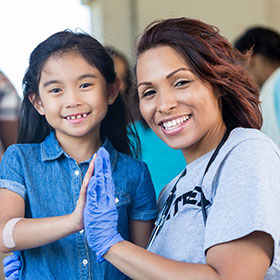White people have better access to health care and better health outcomes in Minnesota. That’s the takeaway from new data released by the State Health Access Data Assistance Center (SHADAC), which shows disappointing progress in dismantling inequitable health outcomes for Minnesotans of color and indigenous Minnesotans. We must do better to ensure that all our Minnesota neighbors can get and stay healthy.
Disparities are very present in access to health care
SHADAC found that 10 percent of all Minnesotans could not get medical care when they needed it due to costs. However, only 8.4 percent of white Minnesotans experienced this barrier while 18.6 percent of Black Minnesotans and 23 percent of Latino Minnesotans did. Minnesota is on a shameful list of four states where this gap between white and black residents is greater than 10 percentage points; the difference between white and Latino Minnesotans is also significant. Also, white Minnesotans have a lower rate of medical cost burden – defined as out-of-pocket spending on health care that’s greater than 10 percent of annual income – compared to African American Minnesotans.
Minnesotans with less formal education are also more likely to face barriers to needed health care. Minnesota is one of 48 states where adults without a high school diploma are significantly more likely than others in their state to forgo necessary medical care due to cost, too.
Additional concerns about disparities in access to health care go beyond the dollars and delve into relationships: 78 percent of white Minnesotans have a personal doctor, while only 72 percent of Black Minnesotans and less than half of Latino Minnesotans do. Research demonstrates that a relationship between doctors and patients leads to better health outcomes, though the “why” is still being explored. A positive relationship between doctors and patients can build trust and make regular visits more likely, which could help prevent health problems or catch them early to maximize treatment options.
Inequitable access to health care contributes to significant disparities in health outcomes
The most shocking research is the relationship between race and premature death. We know that access to affordable health care is literally a lifesaver. Minnesota ranks very well – second only to California – in number of premature deaths, defined as the average number of years of potential life lost prior to age 75 per 100,000 population. However, disaggregating the data by race shows both shocking differences and a lack of change over time in this outcome:
Minnesotans of color and Indigenous Minnesotans experience much higher rates of premature death. In addition to premature death, people of color are also more likely to experience other negative health outcomes, such as more days per month when activities are limited due to mental or physical health difficulties.
Average number of years of potential life lost prior to age 75 per 100,000 population

Source: SHADAC
None of this is new information
Minnesota’s overall high rank among states for various health outcomes masks worst-in-the-nation disparities. The Legislature created the Eliminating Health Disparities Initiative nearly two decades ago to address these challenges. Policymakers, news organizations, and state agencies have been talking about this for years. Research shows economic benefits of addressing health disparities in addition to the ethical issues. And yet these disgraceful disparities persist, harming our Minnesota neighbors and friends.
We must focus on addressing racial disparities and improving health equity to make Minnesota a state where everyone can live their healthiest lives. That’s good for individuals, communities, and the state’s economy.
